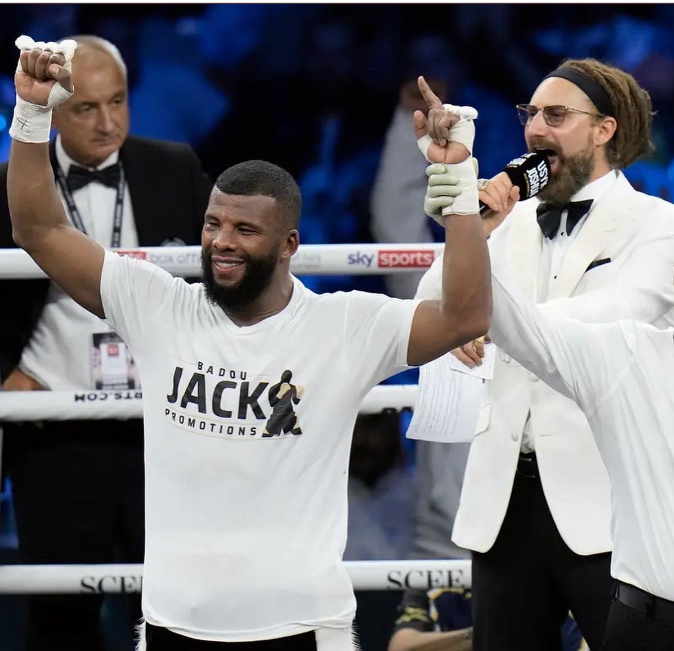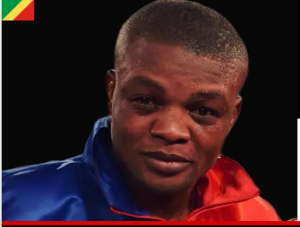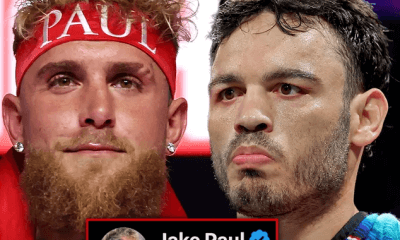Featured Articles
A Closer Look at Jack vs Makabu: A Very Modern Crossroads Fight

Crossroads fights in the 1930s were about ranked contenders vying for a shot at one of only eight championships in all the world. In the 1980s, crossroads combat tended to consist of a past-prime former contender meeting with an up-and-comer in pursuit of one of three belts. Today, in 2023, a crossroads match in the cruiserweight division looks like Ilunga Junior Makabu (29-2) defending his dusty strap against a man that used to hold one of his own at 168 and 175lbs, Badou Jack (27-3-3) this weekend in Saudi Arabia.
Jack’s career has been a mess of confusion. From the moment he stepped into the ring to box for an alphabet title, his ground has been unsure. Jack met with Anthony Dirrell in 2015 at 168lbs for his first bauble, Dirrell sweeping in with single right hands, Jack returning the favour, each trying to counter the other’s jabs. At no time did either man establish dominance and at no time was a decision sure but Jack probably, barely, deserved the majority nod he received. In his first defence Jack met George Groves in a fight I scored a draw where Jack came away with a split. His second defence against Lucian Bute was scored a majority draw, later altered to a disqualification victory for Jack because of Bute’s use of Ostarine. Still with me?
Jack then boxed two more majority draws, this time with James De Gale, who lost a tooth during the fight but apparently managed to bank enough rounds to escape unbeaten (I thought Jack was a little unlucky), in defence of his 168lb strap; then against Adonis Stevenson (the luck here may have run for rather than against him), this time in defence of the 175lb strap he’d picked up against Nathan Cleverly. Three majority draws, a split decision win, a majority decision win and a disqualification win later, Jack finally dropped his title to Marcus Browne. After returning to form with a desperately close decision loss to Jean Pascal in 2019, Jack left 168 and 175 behind forever, departing for cruiserweight. He also began treading water, short of title-boxing and serious purses.
Confusion, too, has been the watchword of the world’s number four cruiserweight Ilunga Junior Makabu, but there was no uncertainty about his 2016 match with Tony Bellew where Makabu was butchered in three. It took him three years to return to the top-tier, against the Russian Aleksei Papin against whom he achieved a majority decision. In truth Makabu looked a winner in that fight, the drilled straight left Makabu seated Papin with in the twelfth seemingly the cherry on a cake made up predominantly of vicious body-punching. The judges though, saw that knockdown as all that separated the two men from a draw. Nevertheless, Makabu was able to return to the Congo for his shot at a belt, beating Michal Cieslak in a torrid affair that perhaps should not have been scored a split – Makabu took it clear. After one more defence in Congo, Makabu put his feet up. He did not box a single contest in the whole of 2021. In January of 2022 he travelled to America for the first time and under the auspices of Don King put his belt on the line against South African Thabiso Mchunu. The result was a fight so close that any narrow card is reasonable – Makabu got the split decision win.
Indeed, Makabu apparently found the decision so desperate that he rewarded himself with the rest of the year off. His story, for all that it is a tale of narrow margins, is somewhat redemptive, but in boxing just once in twenty-six months, he has rendered himself all-but irrelevant despite the strap he wears. He has clung on to his ranking by virtue of modern boxing’s tolerance for inactivity and a formerly thriving 200lb division bereft of intrigue in the wake of Oleksandr Usyk and Murat Gassiev but, in reality, should Makabu lose to Jack this weekend, he is 1-1 since 2020 and the single win is a questionable one. Makabu has been brought to the cusp of gatekeeper status by the most modern of fistic malaise, inactivity. He doesn’t fight so he can’t win – but he also can’t lose which means he has yet to be eliminated.
Explicitly, though, there is nowhere for the thirty-five-year-old Makabu to go should he lose to Jack. Jack, for his part, has been much more active but at a lower level. Out twice in 2022, he knocked out the hapless Hany Atiyo in a round before facing off against his first legitimate test since his loss to Jean Pascal, meeting the American prospect Richard Rivera on the undercard of the Usyk-Anthony Joshua rematch. Many considered Jack a little lucky to get the decision that night but I was not among them. I thought Jack made it close enough that the cards were reasonable and he landed some of the better punches in the fight, including a fizzing right hand at the beginning of the sixth. Jack was at his best throwing such sudden punches, all whip and torque, speedy and unexpected, but a lot of these gifts have departed him now. Jack is thirty-nine and the 168lb fighter that out-slicked Dirrell is gone. Jack cuts a ponderous figure in the ring, slow, fleshy, more than capable of the occasional flighted power-punch but probably no longer able to sustain such punches in bunches.
Still, ponderous but far from unsure. Jack always had one of the better static defences in boxing, another modern manifestation and one that has come about due to changes in the rules. The removal of the thumb and the increased weight of boxing gloves has made defending against weaved punches, already less effective due to the reduce nimbleness in the glove, easier: stick the mitts to the face and tuck in those elbows. Jack was never difficult to hit, but he was always difficult to hit clean and this is an art he has perfected. The reason I thought Jack did better against Rivera than many is that many of Rivera’s punches slid off those gloves by my eye. Jack relies on clean-eyed judging now, but it is a valid form of defence. It has covered for his diminished mobility.
Only on defence though – Jack isn’t going to be able to cut off the ring on many younger cruiserweights. This is in interesting opposition to Makabu’s stylistic cornerstones though; Makabu isn’t going to be running. Makabu’s problems are as old as the sport in that he has to get closer to taller, rangier foes. This has seen him develop a fascinating offensive strategy built around a fine judge of the distance. Makabu “dashes” his offence, quick punches from many different angles, he loves bodyshots, but he uses them to buy headshots, he has a stiff jab, but it is short so he uses the full range of attacking planes to buy himself that punch. In short, he is one big cruiserweight feint, a trickster masquerading as a slugger, a veteran before his time and legitimately one now. He will be right in front of Jack, who will not have to look for him.

Ilunga Makabu
Makabu, though, has become skilled at distance and controlled punching specifically because of his stature relative to his division. He is usually the shorter man with the shorter reach. In his last fight though, he was neither and clearly this threw him stylistically. Thabiso Mchunu has in many ways demonstrated just how a naturally smaller man might handle Makabu. Jack is strategically adept and will be watching that fight. What he will see is that a general defence – his defence – is more efficient here than a punch-picking defence. He will also see that Makabu is there for the type of sudden, unexpected leads that he used to be known for. This is a tantalising combination in any circumstances, but at the crossroads, it will be all the more so. Jack’s shorter reach will likely be no handicap.
Makabu’s strategy will likely hang upon a body-attack that for Jack, soft at the weight, could prove to be a painful one. Could it be that this most cerebral of confrontations could come down to the oldest cliché of them all: who wants it most? It is not impossible. Certainly the equivalent fight fought between much younger, more active fighters in a bygone era could easily have fallen into that type of violence, here it is just one of many possibilities. Will Makabu be rusty, and if so for how long? If he is, can Jack shake off that usual slow start, and if he can, how will that sit with his thirty-nine-year-old frame in rounds ten and eleven? Can Makabu’s variety crystalise to the punches that pierce the Jack guard, and if they do, can Jack uncork enough of those lashing, uncovered right hands to compensate?
There is much to be seen here and it will be seen by millions as this strange contest appears on the undercard of one even stranger. In a final and most modern of twists, Jack and Makabu will box on the undercard of the Tommy Fury-Jake Paul event, subservient to two reality tv stars. Hardcore fight fans such as those that make up the Sweet Science readership will have to decide whether to put money in the pockets of these reality tv stars in order to see Jack-Makabu. It is harder to think of a more complete summary of the strange world of boxing in 2023.
I will be sitting this one out but equally I’ll be looking for news of this crossroads contest that will set the winner on the road to a potentially lucrative showdown with Lawrence Okolie who has the promotional clout to bring the belt to Britain, but sets the loser on the road to retirement. I cannot imagine anyone wanting to see a forty-year-old Badou Jack take another tilt at cruiserweight gold in 2024; should Makabu lose, late 2024 would be about when we could expect to see him again.
In the end, I expect the man to lose out will be Jack. It will be sad to see given his long, strange, storied career but I just don’t see him holding up against that body attack and I just don’t think he is mobile enough to escape it. It could be slow and painful and he could have his right-handed moments but I think it will be a question of whether or not Jack can see the bell rather than win the day.
To comment on this story in the Fight Forum CLICK HERE
-

 Featured Articles4 weeks ago
Featured Articles4 weeks agoAvila Perspective, Chap. 330: Matchroom in New York plus the Latest on Canelo-Crawford
-

 Featured Articles3 weeks ago
Featured Articles3 weeks agoVito Mielnicki Jr Whitewashes Kamil Gardzielik Before the Home Folks in Newark
-

 Featured Articles22 hours ago
Featured Articles22 hours agoResults and Recaps from New York Where Taylor Edged Serrano Once Again
-

 Featured Articles4 weeks ago
Featured Articles4 weeks agoCatching Up with Clay Moyle Who Talks About His Massive Collection of Boxing Books
-

 Featured Articles5 days ago
Featured Articles5 days agoFrom a Sympathetic Figure to a Pariah: The Travails of Julio Cesar Chavez Jr
-

 Featured Articles3 weeks ago
Featured Articles3 weeks agoMore Medals for Hawaii’s Patricio Family at the USA Boxing Summer Festival
-

 Featured Articles1 week ago
Featured Articles1 week agoCatterall vs Eubank Ends Prematurely; Catterall Wins a Technical Decision
-

 Featured Articles4 weeks ago
Featured Articles4 weeks agoRichardson Hitchins Batters and Stops George Kambosos at Madison Square Garden




















